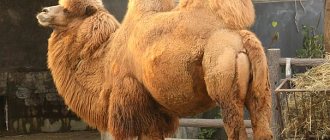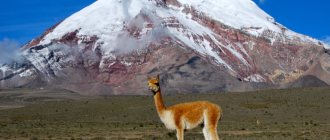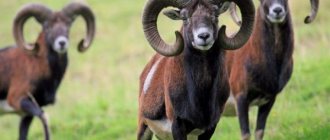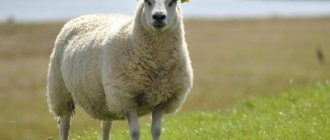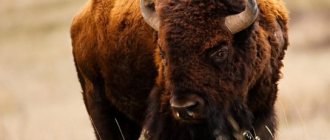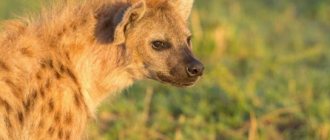Since ancient times, the companion of the southern nomad was the camel - an unpretentious, hardy inhabitant of deserts and semi-deserts. Until now, these animals play a huge role in the lives of many peoples. They are used as horse, pack and horse-drawn transport; camels provide people with valuable wool, milk and meat. Meanwhile, this is one of the most amazing and unusual creatures on our planet.
Types of camels
Camels belong to the genus of herbivorous mammals of the artiodactyl order. Scientists classify them as a separate suborder of callosopods, in which camels and their distant relatives - vicuñas and llamas, living on the South American continent, are the only representatives.
These are large animals, taller than human height, with a long flexible neck, thin legs and a soft fatty hump on the back. Only two types have survived to this day:
- Dromedary camel or dromedary;
- And the two-humped camel is a Bactrian, named after the ancient state of Central Asia, Bactria, where the unpretentious “ships of the desert” were first tamed by humans.
Camel body structure
The camel is a unique example of the adaptation of living organisms to environmental conditions. These hardy, surprisingly unpretentious animals thrive in the arid, sharply continental climate of deserts and semi-deserts, calmly enduring both huge temperature changes and prolonged dehydration.
They are distinguished by a dense, elongated body with a small, elongated head. The structure of the flexible neck, curved in the shape of a “U”, is such that the desert dweller can easily pluck leaves and soft branches from fairly tall trees or pick up food from the ground without bending his long legs. Their ears are small, rounded, and in some breeds they may be almost invisible due to their long, thick fur. The tail, with a small hard tassel, is quite short in comparison with the body, and does not exceed 50–58 cm in length.
The entire body of a camel is covered with thick curly hair, which perfectly protects both from scorching rays and from low winter temperatures. The color of the pile can be different: from light sand to dark brown. Occasionally there are even black animals.
The hump, located on the back of a camel, serves as excellent protection from the burning southern sun and is a kind of storage of nutrients. Its top is covered with longer and stiffer hairs than the rest of the body, and often has a color different from the main color. The shape also plays an important role: for example, in an emaciated animal, the hump sags and resembles an empty wineskin. But it quickly rises and becomes dense as soon as the camel eats and gets enough water.
Nature took special care of the camel's head. Large, widely spaced eyes for better visibility have a third eyelid that protects from dust and sand, and are surrounded by long thick eyelashes. Deep brow ridges also provide additional protection from the wind. At the same time, the vision of humpbacked mammals is excellent: they can spot a person a kilometer away, and they can see a large moving object, for example, a car, even 4–5 kilometers away.
Camels are famous for their excellent sense of smell. Thus, they sense water sources in the desert 50–60 km away. This is largely due to the structure of the nose. The narrow nostrils are covered with a special fold, thanks to which the moisture that inevitably evaporates during breathing flows into the mouth; this protects animals from dehydration, but does not dull their sense of smell.
The nasal openings of a camel have such a structure that they can close almost completely, protecting the respiratory tract from sand and the loss of excess fluid. It is thanks to this feature that camels are among the few mammals that can survive a dust storm without damage, which in the desert has truly monstrous destructive power.
The camel's jaw deserves special mention. There are 38 teeth in the oral cavity, including 4 rather sharp fangs - 2 above and 2 below. In addition to them, the lower jaw has 10 molars and the same number of incisors, and the upper jaw has 12 molars and 2 incisors. A camel can easily bite through a hard thorn or dry branch, and its bite is much more painful than a horse's bite. The fleshy lips of these animals - smooth lower and bifurcated upper - are designed for tearing off tough food and have rough, durable skin.
It is known that camels have a sharp, rather unpleasant odor. Contrary to popular belief, this “aroma” does not come from sweat. Camels practically do not sweat at all (in arid climates, excess moisture loss would be wasteful). But on the back of the head of these animals there are glands with a sharp-smelling secretion, with which males mark their territory by rubbing their heads and necks on trees.
Outwardly, both a two-humped and one-humped camel may seem disproportionate and even fragile due to thin legs, but this is only an appearance. An adult individual can easily withstand many hours of trekking through the desert and is capable of carrying a load equal to half its weight. Cloven hooves with a large horny claw allow them to move freely on rocky and sandy surfaces, and in winter they serve as an excellent aid in obtaining food: with their help, camels dig out edible branches and thorns from under the snow.
These animals are distinguished from other artiodactyls by a characteristic feature: dense skin growths - calluses - in those places where the camel comes into contact with the soil while lying down. Thanks to them, animals are able to lie without harm even on hot midday sand or rocky ground (and in some areas of Asia and Africa, the temperature of the earth in summer reaches 70⁰ Celsius). Similar formations are located on the chest, elbows, knees and wrists of the camel. The exception is wild, non-domesticated individuals: they completely lack elbow, chest and knee calluses.
Thus, these mammals have rightfully earned their name “ship of the desert.” True, all their amazing features also have a downside: the list of places where camels live is not so long. In a humid climate, neither a one-humped nor a two-humped camel can exist, and they very quickly get sick and die.
Description and features
The camel is a large animal that lives in deserts. The animal is very heavy and large, due to which it can carry heavy trunks. An adult camel can reach a weight of up to seven hundred kilograms. In the desert, the camel survives thanks to its hump - one or two, in which it accumulates fat.
Protection from strong sandy desert winds are double and very long eyelashes, as well as narrow, “slamming” nostrils. They close very tightly, providing protection against sand getting into the lungs during storms.
The camel in the photo may not seem big, but its height on average reaches two meters or more. Due to the feeding habits of the animal, the lips have become very rough - this is necessary so that the camel can pluck thorny vegetation and eat it. The camel's upper lip is divided into two parts.
The animal can land on very hot sand and lie on it for a long time. In this case, the camel rests on its calloused knees and elbows. The animal also has a cloven foot and a calloused claw.
This foot structure is ideal for an animal living in the desert - it can move not only on sand, but also on rocky terrain. The camel also has a small tail, about half a meter, at the end of which there is a large tassel.
Where do camels live?
The question of where camels live is quite complicated. On the one hand, thanks to their endurance, these animals are able to live in areas characterized by an arid, sharply continental climate. They are found in deserts and semi-deserts, at altitudes up to 3300 km above sea level. On the other hand, now the number of wild camels is rapidly declining, and their habitat is becoming smaller. The reason for this was human activity: almost all open sources of water in the desert have long been occupied by people, and haptagai, due to natural caution, are extremely reluctant to approach humans. The wild Bactrian camel has been protected for several decades as an endangered species included in the Red Book. Now there are only a few regions where you can still find Bactrians in their natural, non-domesticated form:
- southeast of Mongolia, Trans-Altai part of the Gobi Desert;
- the western, arid regions of China, primarily in the vicinity of the long-dry Lake Lop Nor, known for its salt marshes.
In general, the habitats of wild camels are 4 not too large, isolated areas of deserts and semi-deserts.
As for dromedaries, it is impossible to meet them in the wild. The wild dromedary camel finally became extinct at the turn of the New Era and is now bred exclusively in captivity.
The list of places where camels tamed by people live is much wider. They are used as a means of transportation and draft power in almost all areas with natural conditions close to the desert.
Thus, the dromedary camel is found today:
- in the north of the African continent, in all countries up to the equator (Somalia, Egypt, Morocco, Algeria, Tunisia);
- on the Arabian Peninsula;
- in the countries of Central Asia - Mongolia, Kalmykia, Pakistan, Iran, Afghanistan, in the UAE and Yemen and in other countries up to the northern provinces of India.
- in the desert regions of the Balkan Peninsula;
- in Australia, where dromedaries were brought by settlers in the 19th century instead of horses that could not withstand critical temperatures and extremely low humidity;
- and even in the Canary Islands.
Bactrians can boast of no smaller range. The Bactrian camel is one of the most common representatives of livestock throughout Asia Minor and in northern China, in Manchuria.
According to rough estimates, the population of dromedaries in the world now reaches 19 ml; Of these, almost 15 million live in North Africa alone.
Camels are rightfully revered by many peoples almost as sacred animals. After all, not only trade, but also the lives of people in many areas of our planet depend on them.
Camels are giants with two humps
The two-humped giant of the entire camel family is distinguished by its unique ability to survive in conditions that are destructive for other living beings.
Reliability and benefits for humans have made the camel since ancient times a constant companion for the inhabitants of Asia, Mongolia, Buryatia, China and other areas with a dry climate.
Etymology of the name
Linguists have been arguing about the origin of the name of this unpretentious representative of the desert fauna for centuries, but not a single theory has yet been recognized as the only correct one. The difficulty lies not only in the fact that in different countries the “ship of the desert” is called differently, but also in the too large gap separating modernity and the ancient world. Over the 4,000 years that have passed since the domestication of the camel, the language of different countries has undergone enormous changes, borrowed words managed to become “indigenous” and then become obsolete. However, some assumptions can be made.
The camel has been known to people living in arid desert regions since ancient times. In the life of a Bedouin, he played the same role as a horse in the life of a steppe nomad. Comrade in arms, transport, carrier of heavy loads... And also - nutritious milk, wool for clothing, shelter from a sandstorm, meat in a hungry year - all this is a camel. It is not surprising that each nation gave its own name to its faithful companions. Thus, in the Kalmyk steppes the majestic hunchbacked giant is still called “byurgud”, in the north of Africa - “mehari”, and in Farsi this animal is called the word “ushtur”.
The Latin name of these animals sounds like “Camelus”, and, according to the most common theory, goes back to the Arabic name “جَمَل” - “gamal” in our usual transcription. All Western European versions of the camel name come from the Latin term: in English-speaking countries it is called “camel”, in Germany – “Kamel”, the heirs of the Roman Empire, the Italians use the word cammello, and the Spanish version sounds almost the same – “camello”. The French went a little further - their “ship of the desert” is called “chameau”.
There is much more controversy surrounding the Russian name of this animal. There are three versions of the origin of the word “camel”:
- According to the first, the term is a highly distorted borrowing from the Latin language. The Romans, who had colonies in Africa and Asia, knew many large riding animals that were unfamiliar to European inhabitants. One of them, elephantus, meaning elephant, found its way into the Gothic language and was eventually adapted to ulbandus. The Slavs, unlike the Goths, who settled in the lands from present-day Germany to the Balkan Peninsula, lived much further north, and mistakenly used this term to define the large double-humped transport of their southern neighbors.
- The second version can be considered a complement to the first, since it can explain how the Western “ulbandus” could transform into the Russian “camel”. The Old Slavonic transcription of this word did not have the letter “r” and sounded like “velьbǫdъ”. This form of the name is used in many Old Russian texts, for example, in “The Tale of Igor’s Campaign.” The two semantic roots of “welblood” are translated into modern ones as “big, great” and “to walk, wander, wander.” This is a completely viable theory - the camel is indeed considered one of the most durable riding animals, capable of covering up to 40 km or more per day.
- According to some linguists, the word “camel” came to Russia from Kalmykia, where the word “burgud” is still used.
What do camels eat and what do they eat?
Everyone knows that camels are one of the most unpretentious animals in terms of food. They are able to digest even those foods that other mammals do not touch and can live for a long time without food. The list of what camels eat is quite long. It includes:
- grass, both fresh and already faded in the sun;
- leaves of trees, especially poplars (in the cold season this is the basis of the camel’s diet);
- barnyard;
- camel thorn (so named because other animals are unable to digest its tough fiber);
- ephedra
- sand acacia;
- sagebrush;
- parfolia;
- steppe onion;
- saxaul branches;
- and some other types of shrubs.
The diet largely depends on where camels live. So, at home, these mammals happily eat grain, hay, silage, fruits and vegetables, as well as any other plant foods. The answer to this unpretentiousness lies in the structure of the camel’s digestive organs. Its stomach has three chambers and is capable of digesting even the coarsest and, at first glance, nutrient-free food. In this case, animals swallow food without chewing, and after a few hours they regurgitate the semi-digested mixture and slowly chew it.
Camel spit, contrary to popular belief, does not consist of saliva, but of partially digested chewing gum.
The one-humped camel is considered more picky in terms of nutrition than the two-humped camel. Thus, during a hungry period, Bactrians are quite capable of eating animal skins and even bones, while dromedaries are forced to make do exclusively with plant foods.
It has been noticed that a strict “diet” has a much better effect on these amazing creatures than a plentiful diet. In years of famine, the survival rate of the population in winter is much higher than during periods when there was enough food in the summer. All camels can withstand hunger and thirst without harm. An adult animal can go without food for up to 30 days, accumulating nutrients in its humps and subsequently subsisting on them.
Equally phenomenal is the ability of these mammals to withstand thirst. In the absence of any source of moisture, a dromedary camel can live 10 days if it does not expend energy by running or carrying heavy objects. During the period of activity, this period is reduced to 5 days. The Bactrian camel is less hardy in this regard: for it, the period of abstinence in hot weather is limited to 3, maximum 5 days.
In many ways, these unique qualities are associated with the structural features of the blood. In camels, unlike other mammals, red blood cells are oval in shape, which makes them better able to retain moisture. “Ships of the Desert” can withstand dehydration up to a quarter of their own weight (while for other mammals, a loss of fluid of 15% is already fatal). These amazing creatures can even get moisture from food. Thus, lush grass supplies camels with enough fluid, and on fresh pastures they can go without water for up to 10 days.
However, there are other reasons for such phenomenal endurance:
- Both Bactrians and dromedaries lead an inactive lifestyle, thereby expending energy very slowly.
- Camels practically do not lose moisture during their life. The steam exhaled from the nostrils precipitates and flows into the oral cavity. The intestines process body waste, almost completely absorbing the liquid (this is the reason that camel feces are often used by desert dwellers as fuel for fires). Camels begin to sweat only if their body temperature rises above 40⁰ and there is a real threat of death from overheating, and this happens extremely rarely.
- The camel's body is designed in such a way that during a season rich in food and water, the necessary substances accumulate in its body, gradually being consumed until the time when the animal cannot replenish its reserves.
How long can a camel go without water?
How long do you think a camel can live without water? The answer is impressive: up to 15 days. And without solid food - about a month. True, after this the camel will need several days of rest and proper nutrition. In addition, after such a long hunger strike, an animal can drink up to one hundred liters of water at a time!
By the way, by the appearance of the hump you can determine how long its owner has been starving. So, in a well-fed and watered camel, the growth on the back stands straight, while in an exhausted camel, it hangs to the side. The fact is that camel humps lack bones and joints. Therefore, when an animal’s fat reserves dry up, its humps decrease in size and sag.
Thus, a camel can live without water for several weeks. And without significant harm to your health. Not only humps help him with this, but also other opportunistic “life hacks”. For example:
- Camels control their breathing rate to minimize water loss from the body.
- Thick fur protects the animal’s body from both scorching heat and night cold.
- Liquid is also stored in special water-bearing sacs in the stomach, which further helps the camel fight dehydration.
- The moisture exhaled from the camel's nostrils is retained in special sinuses and then enters the mouth.
Domestic camels
For many regions, these animals are not only the optimal means of transportation, but also the only livestock that can easily withstand difficult climatic conditions.
Camel wool plays a huge role in the economy. It is valued much higher than goat or sheep, because due to the large mass fraction of fluff (about 85%) it provides excellent warmth in cold weather. From a dromedary you can get from 2 to 4 kg of wool per year; but the average annual harvest from Bactrian reaches 10 kg.
An impressive portion of the diet of many peoples living in desert areas is occupied by products made from camel milk - cheese, butter, fermented milk drinks, such as Turkmen chal or Kazakh shubat. A camel gives from 2 to 5 liters of milk per day; however, this amount largely depends on the breed of the animal. Thus, the annual yield from Bactrian rarely exceeds 750 - 800 liters. But for dromedaries, 2 tons of milk per year is the norm, not to mention Arvans, from which you can get 4 or more tons per year.
The fat content of camel milk is higher than that of cow milk, reaching 5.5% for Bactrians. In dromedaries this figure is slightly lower - 4.5%. It is rich in many microelements, including iron, calcium, magnesium, and the vitamin C content in it is even higher than in cow or goat milk. Due to its low content of caseic acid, it is easily digestible, has a foamy appearance and a sweetish taste.
In ancient times, camels were often used as fighting animals. The four-legged warrior carried two riders into battle: a driver in front and an archer behind. And in the case of hand-to-hand combat, the camel itself turned into a rather dangerous weapon, because it was capable of not only kicking, but also using its teeth. And on the main square of the small town of Aktyubinsk, Astrakhan region, there is a monument to two camels named Mishka and Mashka: they were the ones who carried the gun mount, which was one of the first to begin shelling the Reichstag in May 1945.
Camels have long been used as riding and cartage animals. They are able to freely carry a load equal to half their own weight. Outwardly, these imperturbable “ships of the desert” give the impression of slow and phlegmatic animals. However, this is due not so much to their character as to the need to retain moisture, which is consumed much faster during activity. A camel is indeed a very calm animal, and it is not so easy to make it run, wasting precious energy. But they are capable of walking at a measured pace, without getting tired, for hours, covering a distance of up to 50 km per day, and with constant urging, up to 100 km.
In some countries, the size of the bale a camel can carry is the official measure of weight. It is equal to 250 kg.
In many Arab countries there is a national sport - camel racing. For example, in the UAE, such competitions are held every week, starting from April and until October, when the rainy season continues. On the roads here you can see the usual warning sign for local residents: “Caution! Camels!
Camel milk
This product is valued by residents of Asia. It is sweet and nutritious (fat content 5-6%) and full of useful substances. Over the course of a year, a camel produces 300-1000 liters of milk.
These are very beautiful animals, as evidenced by the huge number of beautiful photos of camels.
Wild and domesticated camels: differences
The ancient ancestors of modern camels were widespread across large parts of Eurasia, North America and the Arabian Peninsula. It was there, according to scientists, that these hardy creatures were first domesticated by humans around the 2nd millennium BC.
To this day, only the Bactrian camel has survived in its wild, original form; The dromedary is found in the natural environment exclusively as a domesticated, secondarily feral animal. In fact, the very existence of wild camels was officially confirmed only at the beginning of the 20th century, during an Asian expedition led by Przhevalsky. It was he who discovered the existence of wild Bactrians, called “haptagai”.
The haptagai camel has several noticeable differences from its domesticated ancestor:
- their hooves are distinguished by a narrower shape, compared to domestic camels;
- the physique of wild camels is lean and dry, with a more elongated muzzle and short ears, and their height and weight are slightly less than those of a domesticated animal;
- a hump that is not so spacious makes wild camels more vulnerable during drought or famine;
- but the easiest way to distinguish a haptagai is by his clean legs and chest, without the slightest trace of calluses.
Now wild camels are on the verge of extinction: their total number in the world barely exceeds 3,000 individuals.
Population and species status
If wild one-humped camels became extinct in prehistoric times, then the two-humped camels did not suffer a similar fate, and they exist on our Planet in a wild form.
Important fact! Nowadays, there are not many wild Bactrian camels left, so they are listed in the International Red Book. They are classified as CR, which corresponds to a species that is on the verge of extinction.
For the sake of fairness, it should be clarified that wild Bactrian camels became rare at the beginning of the last century. If we talk about the current time, then their existence is under threat. The degree of threat is so high that wild camels rank eighth among all animals on our Planet that are on the verge of extinction.
Lifestyle of Khaptagai camels
Camels in the wild lead a nomadic life, constantly migrating from one source of water to another. They usually roam in small families, from 5 to 10 - 15 individuals. They include one adult male and several females with cubs. Adult males usually roam alone, occasionally joining herds and leaving during the rutting season. Large herds can only be found at watering places, where the number of camels can reach several tens of thousands of heads.
Like domestic camels, khaptagai are diurnal animals. At night they are not active, but during daylight hours they are in constant motion.
Despite constant migrations, the places where camels live are clearly demarcated. These animals do not leave their natural habitat, staying close to springs and oases. As a rule, in the summer they roam in the northern regions, and with the onset of cold weather they move further to the south. At this time, they can be found in oases rich in trees, in the foothills, where it is easy to find protection from the wind, as well as in shallow ravines.
dromedary camel
The species of camels that have survived to this day are not very diverse and include only two items: the two-humped Bactrian and the single-humped dromedary.
The one-humped variety of the "ship of the desert", unlike its larger relative, is considered not so much a horse-drawn animal as a racing animal. The very name “dromedary” or “Camelus dromedarius” comes from ancient Greek as “one who runs”, “runner”. It has a shorter height (no more than 190 cm, rarely 210 cm) and is inferior to its two-humped relative in weight, due to which it is capable of developing significantly greater speed.
But in terms of cold resistance, the dromedary camel is more vulnerable. It does not tolerate the cold in the desert well due to its not too thick coat, which protects well from the heat, but does not warm well.
Another distinctive feature of dromedaries is their short, shaggy mane, which starts from the back of the head and turns into a beard, ending in the middle of the neck. There are the same “decorations” on the back, in the area of the shoulder blades. The fur of these animals, as a rule, has a sandy shade of varying saturation, although brown, gray-red and even extremely rare white individuals are occasionally found.
The dromedary camel has other names. So, in many countries it is called “Arabian” - after the name of the area where these animals were first domesticated. It was from the Arabian Peninsula that the leisurely giants with one hump began their triumphal march around the world.
General characteristics
A camel is an animal that, due to its physiological structure, is adapted to survive in harsh conditions.
To date, there is no land vehicle that can overcome difficult terrain in the deserts, as a camel can do. He is able to remember any path with unique accuracy, which allows him, even in bad weather conditions, not to stray from the route he has already taken.
Bactrian camels
The second name of this species comes from the ancient state of Bactria, located in Central Asia (the first information about these animals is found in documents from that particular region). Bactrians are much more massive than dromedaries, their height reaches 230 cm, and the saddle between the humps is approximately 170 cm from the ground. The distance between the bases of the humps ranges from 20 to 40 cm.
The Bactrian camel has a long neck, due to the strong bend of which the head and shoulders of the animal are located at the same height (which is not typical for the one-humped representative of these mammals).
The fur of Bactrians is very thick and dense, allowing them to easily withstand extreme cold. In winter, its length reaches 7 cm on the body and 25 on the tops of the humps. But with the onset of warmer weather, the two-humped giants begin to shed, which is why they look rather untidy in the spring - until the period when the hair grows back.
Natural enemies
Modern camels are very lucky because they are deprived of such a predator as a tiger, but in the past tigers hunted not only wild but also domesticated camels. This was possible within Lake Lob Nor, but after irrigation work, tigers disappeared from these areas. Despite their very large size, Bactrian camels were absolutely defenseless, especially if they found themselves in the quagmire of salt marshes. Tigers attacked domesticated camels no less often, so people tried to constantly pursue this predator. This was typical for many camel-breeding areas.
Important point! Various diseases, and there are many of them, have a serious impact on the camel population.
A dangerous natural enemy of camels is the wolf, which annually reduces the number of such animals. Moreover, this is typical for both wild and domestic animals. In addition, camels are quite fearful animals that do not know how to stand up for themselves. When wolves attack, camels only spit and scream loudly. Crows can also peck at wounds on the body of these animals, which indicates the complete defenselessness of camels.
Camel breeds
Despite the fact that currently there are only two species of these unpretentious animals, several varieties are bred in the world, which have many differences from each other. So, only in our country there are 4 breeds of camels:
- Mongolian;
- Kazakh;
- Kalmyk (the largest in the world - it is bred mainly for wool and meat);
- and the Turkmen Arvana, famous for its wool.
Of these, only the long-haired Arwana is single-humped. But in Arab countries the number of breeds is approaching 20:
- Omani;
- Sudanese;
- majaim;
- azael;
- mania, famous for its excellent running qualities;
- al-hajin (also used in horse racing);
- and others.
Despite the large number of names, the differences between Arabian camel breeds are insignificant. Thus, both the Sudanese and Omani varieties and manias are used in horse racing and are not inferior to each other.
Camel farming in Russia
In Russia, camel breeding is developed only in those regions where the animals feel comfortable, in their own climatic zone.
In our country, breeding of 4 breeds of humpback mammals is practiced. One-humped Arvan and Kalmyk, Mongolian, Kazakh varieties of two-humped Arvan.
Animals provide meat, milk, wool. Traditional drinks, cheeses, and butter are prepared from milk (its fat content is about 4.5-5.5%). Wool is in demand in clothing production.
A female dromedary allows herself to be milked only by one person who has managed to earn her trust. If she has a cub, it must be in line of sight.
The wool yield is greater in Bactrian. One animal produces up to 10 kg of wool per season. Haircuts are carried out in the spring.
Camel hybrids
The endurance and usefulness of camels in farming are so great that attempts to crossbreed and breed new species have not stopped to this day. Unlike many other animals, hybrid camel species are quite viable.
"Mestizos" include:
- “Nar” is a large, weighing up to 1 ton, hybrid of the one-humped Arwan and the two-humped Kazakh camel. A distinctive feature of this breed is one large, as if consisting of two parts, hump. Nars are bred primarily for their milking qualities - the average milk yield per individual is 2,000 liters per year.
- "Kama". This hybrid of a dromedary camel and a llama is distinguished by its short height, on average from 125 to 140 cm, and low weight (it does not exceed 70 kg). This baby does not have a standard hump, but it has excellent load-carrying capacity and is often used as a pack animal in hard-to-reach places.
- "Iner", or "Iner". In order to get this one-humped giant with magnificent hair, a female Turkmen camel breed is crossed with an Arvan male.
- “Jarbay” is a rather rare and almost non-viable subspecies, born from the mating of two hybrids.
- "Kurt." A not very popular one-humped hybrid of a female Inera and a male camel of the Turkmen breed. Despite decent milk yield per individual, they are rarely bred due to the low fat content of milk and unsatisfactory wool characteristics.
- "Kaspak". But this hybrid of a Bactrian camel and a female Nara (they are often called Nar-Maya, adding a feminine suffix to the breed) is very popular. It is grown mainly for its large milk yield and impressive meat mass.
- "Kez-nar." A hybrid of a camel of the Turkmen breed and a caspak, considered one of the largest both in size and in terms of milk yield.
Camel breeding
Reproduction in camels follows the same pattern as in many artiodactyls. The rutting period for these animals is quite dangerous, both for the camels themselves and for people. Sexually mature males become aggressive, and in the fight for a female, they attack their opponent without hesitation. Brutal battles often end in death or injury to the losing side: during the battle, animals use not only their hooves, but also their teeth, trying to knock the enemy to the ground and trample him. Males participate in the rut starting from the age of 5 (in females, puberty occurs much earlier - already at 3 years.)
Camels mate in winter, when the rainy season begins in the desert and there is enough water and food for the animals. Moreover, the rut of dromedaries begins a little earlier than that of Bactrians. After a gestation period, which lasts 13 months for one-humped individuals and 14 for two-humped individuals, one, or rarely two, cubs are born, which within a few hours are fully on their feet and are able to run after their mother across the desert.
Camel cubs vary in size. A newborn Bactrian camel weighs from 35 to 46 kg, with a height of only 90 cm. But a small dromedary, with almost the same height, reaches a weight of almost 100 kg. Both one-humped and two-humped camel species nurse their cubs for 6 to 18 months. And parents show care for their offspring until the cub reaches adulthood.
Interesting fact
Camels retain fluid in the scar tissue of their stomach, which protects their body from dehydration. In the complete absence of water, it can live for one month; it replaces the lost weight already at the first drink, drinking approximately 100 liters of water at a time.
Camels have highly developed eyesight and sense of smell; they are able to spot a person 1 km away and sense water while being 40-50 km away.
They are very good swimmers, they run at an amble, developing speeds from 30 to 70 km/h.
Before setting off, camels make a voice reminiscent of the braying of a donkey.
Camel speed
Camels are famous as excellent runners. The average speed of a camel is even higher than that of a horse - from 15 to 23 km/h. There have been cases when a dromedary (which in some literary sources is poetically called a “desert walker”) reached speeds of up to 65 km/h.
Unlike the fast dromedary, the Bactrian camel is not capable of a fast forced march due to its more impressive mass. It is also capable of moving at a speed of 50 - 65 km/h, but it runs out of steam much faster than its one-humped relative. Therefore, on the Arabian Peninsula, in Central Asia and Africa, Bactrians were more often used as horse-drawn transport. Thus, on the coat of arms of the Chelyabinsk region, where the trade route to Iran and China once passed, it is a two-humped giant loaded with bales that is depicted.
Character and behavior
Still think that the most stubborn creature on the planet is a donkey? You are wrong! After all, among all the animals domesticated by humans, there are no more wayward and obstinate pets than camels. It is almost impossible to force him to do anything, and neither screams nor blows with a whip have any effect on the camel. And if the animal decides to rest and lie down, then even the joint efforts of five people will not move it from its place.
The owner feeds his faithful camel corn
At the same time, camels become very attached to their owner. And if a person has managed to find the right approach to his stubborn pet, then he becomes tame and docile, fulfilling all the person’s orders without delay. It’s hard to believe, but sometimes a sold camel returns to its previous owner, and such funny situations cause loud fights among nomads.
Bedouin Arabs value camels very much, considering them sacred animals. There is even a beautiful legend among nomadic tribes that humanity received a camel as a gift from the hands of Allah himself. The myth says that when Allah created people from soft clay, at the end of the work he was left with a small piece of clay. The creator divided it into two parts and threw it on the ground: from one piece a date palm grew, and the second lump of clay turned into a camel.
Camel training
Recommended by topic
Anteater Ferret (ferret) Lion
When young camels turn 1.5 years old, they are taken away from their mothers and prepared for pack or riding activities. By the way, the learning process itself begins when the young animals reach 3 years of age, and until this moment the mushers establish contact with the pet and study its disposition. If the baby camel is calm and obedient, then it will be used for transportation. Nervous and unbalanced animals face a worse fate - such camels are destined for slaughter.
Interaction with people
Most shepherds and camel drivers know that these are shy and vulnerable animals, and force and cruelty should not be used against them. When treated well, humpbacked creatures are friendly and obedient in nature and never try to bite or kick their owner.
It is generally accepted that camels are not very smart, although some of the habits of these animals prove the opposite.
If the owner treats his pets poorly, the leader can run away from him, taking the entire herd with him. And what is most surprising is that when the alpha male sees that the owner has unfairly punished a member of his group, he will definitely take revenge on the person by spitting or kicking him.
Question to the expert
How fast do camels move?
Typically, these animals move at a slow pace - from 3 to 5 km per hour. But if necessary, a camel can be very playful, reaching a speed of 15-25 km per hour. There are cases when one-humped dromedaries even exceeded horses in speed, accelerating to a pace of 50-65 km per hour.
Tourist riding camels
As for strangers, camels behave with them quite calmly and calmly, and will not just spit on them. And the fact that tourists suffer the most from the foul chewing mixture is their own fault. After all, European and American visitors can be very noisy and intrusive, and deliberately tease the animal. Of course, a camel does not tolerate disrespect, so it responds with a well-aimed spit. Oh yes, it's worth mentioning that camels are deliberate in their selection of prey, and they have amazingly accurate aim. So, if you come up with the idea to annoy a desert dweller, then rest assured that he will not miss, and you will have to wash the foul-smelling, sticky mass from your face and clothes.
How much does a camel weigh?
These mammals are distinguished by their rather high growth: 190 – 230 cm at the withers, and males are always slightly larger than females. Body length can vary from 230 to 340 cm for dromedaries, and from 240 to 360 cm for their Bactrian counterparts. The question of how much a camel weighs is controversial. So, on average, the weight of an adult varies from 300 to 800 kg for different breeds. However, there are individual giants whose mass reaches 1 ton. The largest representative of this family is the Bactrian camel, and the smallest is the Cama, a hybrid of a dromedary and a South American llama. The maximum weight of this baby does not exceed 70 kg.
